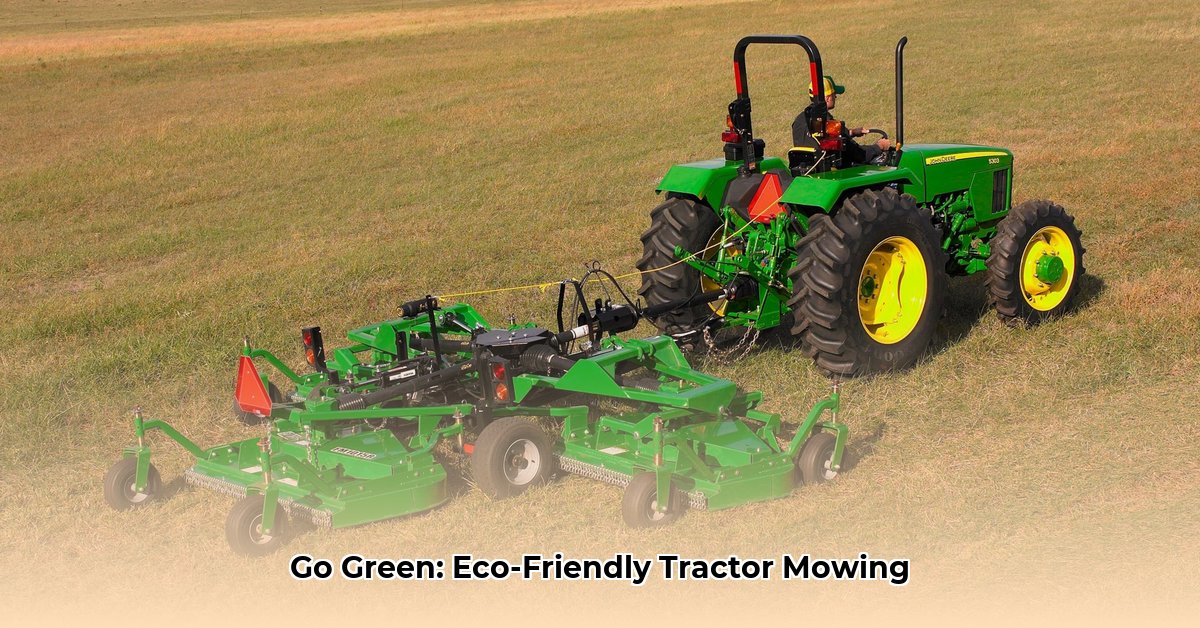
Matching Your Tractor and Mower: A Powerful Partnership
Choosing the right finish mower for your tractor requires careful consideration of several factors. The first, and arguably most important, is ensuring compatibility between your tractor's power and the mower's demands. A mismatch can lead to reduced efficiency, increased wear and tear on your equipment, and potentially even damage. For more information on tractor implements, check out this helpful resource: tractor implements.
- PTO Horsepower (hp): Your tractor's PTO (power take-off) horsepower rating determines how much power is available to operate the mower. This is a critical specification found in your tractor's owner's manual. Selecting a mower with PTO requirements exceeding your tractor's capacity will result in inefficient operation and potential damage. Underpowering the mower, conversely, is wasteful and inefficient. Always check your tractor's manual!
Cutting Width: Speed vs. Soil Health
Mower cutting width significantly impacts both efficiency and soil health. Wider cutting decks offer faster mowing times, but they come with trade-offs.
- Larger Cut, Larger Impact: Larger mowers typically require more powerful tractors, leading to increased fuel consumption and potentially greater soil compaction. Soil compaction reduces water and nutrient infiltration, negatively affecting long-term soil health. Think of it like squeezing a sponge – it’s harder for water and nutrients to reach roots.
- Smaller Cut, Better Soil: For smaller fields or those with sensitive soil types, a narrower mower might be preferable, even if it increases mowing time. The benefits to soil health often outweigh the slightly increased time commitment.
Discharge Methods: Where Do the Clippings Go?
Different discharge methods offer distinct advantages and disadvantages in terms of both efficiency and environmental impact.
- Rear Discharge: Rear discharge mowers spread cut grass evenly across the field, returning nutrients to the soil. This acts as a natural fertilizer while minimizing the risk of plant damage and uneven growth.
- Side Discharge: Side discharge mowers can lead to grass clumping, potentially damaging crops and hindering even growth. While they might appear faster, the downsides can outweigh this advantage. The ideal method will depend on the type of crop and soil conditions. Experimentation is key to finding the optimal approach for your fields.
Fuel Efficiency: Saving Money and the Planet
Fuel efficiency is crucial for both financial and environmental sustainability.
- Tractor Efficiency Matters: The tractor's own fuel efficiency is a major factor. Consider the fuel economy of your tractor model when making your decision. Some models are significantly more efficient than others. Explore options like biodiesel or electric tractors where feasible, even if initial costs are higher.
- Mower Design: Mower design also plays a role in fuel consumption. Careful mower selection can result in significant savings over the life of the machine significantly impacting your carbon footprint and operating costs.
Minimizing Soil Compaction: Protecting Your Soil's Health
Soil compaction is a major concern in sustainable agriculture.
- Weight and Tire Pressure: Heavy tractors and mowers compact soil more, reducing water and air penetration and thus hindering plant growth. Consider using wider tires to distribute weight more evenly and explore lighter mower options where possible. Even modifying your mowing pattern to avoid repeatedly driving in the same tracks can improve soil health. No-till farming techniques can also be highly effective at minimizing soil compaction.
Maintenance for Longevity: Keeping Your Mower in Top Shape
Regular maintenance is vital for extending mower lifespan and minimizing environmental impact.
- Preventative Measures: Sharpening blades, lubricating moving parts, and promptly addressing any issues prevents major problems down the line, reducing costly repairs or premature replacements. Consider this ongoing maintenance an investment in sustainability.
Understanding Your Needs: A Step-by-Step Guide
Before making a purchase, carefully assess your farming operation to determine the best mower for your needs.
- Assess Your Acreage and Terrain: Determine your field size and the type of terrain (slope, soil conditions). This impacts mower size and power requirements.
- Define Your Goals: Prioritize your goals – speed, fuel efficiency, soil health, or a combination. This will help in narrowing your options.
- Research Mower Models: Explore various models, comparing specifications, fuel efficiency, and features. Consider reviewing independent reviews besides manufacturer information.
- Match Tractor Power: Ensure your tractor has the PTO horsepower required by the chosen mower.
- Analyze Long-Term Costs: Evaluate the total cost of ownership, including the initial purchase price, fuel consumption, maintenance expenses, and potential productivity gains.
- Check Regulations: Consider local regulations regarding noise pollution and emissions. This might influence your choice and future equipment upgrades.
Dr. Anya Sharma, Agricultural Engineer, Purdue University, emphasizes, "Prioritizing fuel efficiency and minimizing soil compaction are crucial steps towards more sustainable agricultural practices. Careful mower selection and responsible operation are key to achieving these goals."